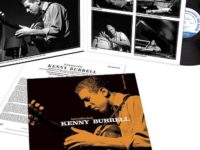NICK DERISO: This Smithsonian Folkways release, issued today, is a hot-dawg compilation that sets up both as primer for the new-to-this and reminder for the been-there-done-that crowd.
A remarkably deep catalogue has helped the label continue for years with a series of myth-confirming sets. “Classic Piano Blues” is no different, featuring everything from Meade “Lux” Lewis to Champion Jack Dupree, from Kentwood, La.-native Little Brother Montgomery to Memphis Slim (appearing on “Wish Me Well” with bassist/Chess Svengali Willie Dixon).
And, in so doing, the record manages to take in the full breadth of piano styles — including boogie-woogie, midnight chock- or barrelhouse, stride, riverboat saloon tunes, even more sophisticated jazz (notably from Sammy Price).
I’m struck all over again, though, by one Huddie “Lead Belly” Ledbetter (pictured a right).
Each of these artists originally recorded full-lengths for the Smithsonian’s boutique label, founded in 1948 by Moses Asch to showcase American originals. Asch started with one of the signature models, though, in Lead Belly — a multi-instrumentalist who gained that nick during legendary playing days around the red-light district of Fannin Street in Shreveport. (His “Big Fat Woman,” which has a title that says it all, is found here with Ledbetter on piano rather than at the more-familiar guitar.)
There is, inside Ledbetter’s music, a synthesis of every important local roots vibe that came before him, including blues and prison songs, but also ballads and cowboy minstrels. He belongs in the conversation with 20th century folk pioneers like Woody Guthrie, and maybe collections like this one will help him get there.
“Classic Piano Blues” makes other important connections: Chicago-born Jimmy Yancey, himself an important voice in the advancement of blues piano, later mentored 1930s-era stars like Lewis and Albert Ammons between stints at his day job as a groundskeeper for the White Sox. Meanwhile, W.C. Handy’s daughter Katherine shows up doing “Yellow Dog Blues” with Johnson, in World War II-era recordings.
The Memphis sound occupies an important role, too, with Bookie T. Laury (originally known, actually, as “Slop Jar”) and Memphis Slim (real name: Peter Chatman) opening the disc. Rufus Perryman, or Speckled Red, also called Memphis home for a time.
There are tragedies revealed: Clarence “Pinetop” Smith released “Pinetop’s Boogie Woogie” in 1928, setting off a craze — and giving the sound its name. (We hear both Montgomery and Memphis Slim banging through versions of the tune on “Classic Piano Blues”; Chatman also includes the vocal.) Smith was later killed as an innocent bystander in a Chicago shoot out.
Several other featured performers recorded sides for Asch during the 1960s so-called “folk blues” revival — including Dupree (an expatriate New Orleans native), Lewis and James P. Johnson. The Smithsonian label ultimately explored more fully both the Deep South repertoire but also how it came to be refashioned with the northward migration of American musicians.
That plays out on this CD in sessions with St. Louis legends like Roosevelt Sykes, Henry Brown, Victoria Spivey, and the ageless Henry Townsend.
- How Deep Cuts on ‘Music From Big Pink’ Underscore the Band’s Triumph - July 31, 2023
- How ‘Islands’ Signaled the Sad End of the Band’s Five-Man Edition - March 15, 2022
- The Band’s ‘Christmas Must Be Tonight’ Remains an Unjustly Overlooked Holiday Classic - December 25, 2016




